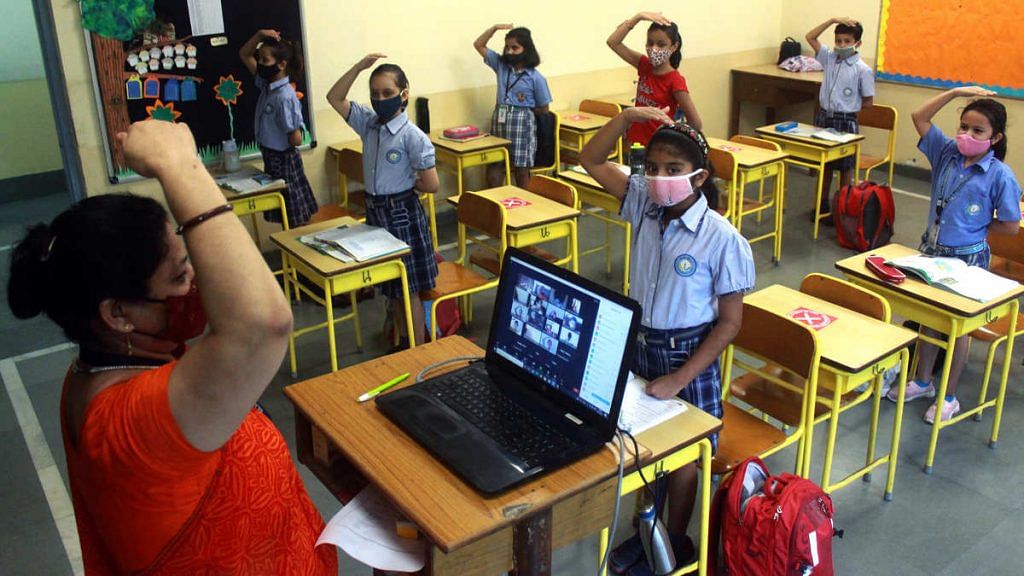New Delhi: While price talks for India’s lone approved vaccine for children (12-18 years) continue, a few questions remain unresolved, delaying any concrete blueprint to roll out Covid vaccination for minors.
The questions include the comorbidities to cover on priority, and which documents to accept as proof of the conditions, senior government officials told ThePrint. Nearly 40 per cent of the Indian population is aged below 18 years.
“The NTAGI (National Technical Advisory Group on Immunisation) working group (on Covid) has been having spirited discussions on these questions — whom to cover and how to ensure that the process is both easy for parents and foolproof,” a senior official in the Union Ministry of Health and Family Welfare told ThePrint.
“We are waiting for them to reach a decision on this. Talks with Zydus Cadila are still on and we hope to have a positive outcome soon.”
The company’s needle-free vaccine, Zycov-D, has been approved for use in children aged between 12 and 18 years.
Bharat Biotech’s Covaxin, currently being used in the national programme, has also been recommended for use in children as young as two years old by an expert panel vetting vaccines.
However, the Covaxin data for young people is still being examined by the Drug Controller General of India (DCGI), and the vaccine has yet to receive emergency-use authorisation for use in minors.
Without determining the list of comorbidities, clarity will also be elusive on the number of Indian children who can hope to get the vaccine this year. This, even as schools in most states have either switched back to offline education, or instituted a hybrid mode where parents can choose whether their children want to attend online or offline classes.
For those without comorbidities, officials say, it is likely that the wait for a vaccine could extend to 2022.
Dr N.K. Arora, chairman of the Covid vaccine working group of the NTAGI, sent a one-line reply to ThePrint’s specific queries about the number of children who can expect to get the vaccine this year, and the numbers that have existing diseases and need an early cover. “Work in progress. No list finalised,” he said on text message.
NITI Aayog member (health) Dr V.K. Paul, who is also co-chair of the National Expert Group on Vaccine administration for Covid (NEGAVC), didn’t respond to calls and a WhatsApp text from ThePrint.
Also Read: Would you enroll your kid for Covid vaccine trial? Find out why these parents have
‘Same process as for adults’
A member of the Covid-19 working group said discussions are on but it is expected that the documentation for vaccinations in children would be “similar to what was done in adults”.
In April this year, when India opened vaccinations for people aged over 45 years with comorbidities, a prescription from any registered medical practitioner was acceptable as proof of the disease. Subsequently, in May, when vaccinations opened up for all adults, that requirement was automatically done away with.
“We are clear that children who have comorbidities should get the vaccine on priority. We are hoping to use the same system as we had done for adults but we also want to make it as simple as possible for parents. That is what we are discussing right now,” said a member of the NTAGI’s Covid-19 working group.
“As for Covaxin, we have not seen the data yet. Yes, our recommendations are taking a little time but that is not the only thing that is holding up vaccinations of children. Do you know how much the Zydus vaccine will cost?” the member asked.
It has been over two months since Zycov-D was approved for emergency use, but the Government of India has been unable to reach an agreement on the pricing of the vaccine, which uses a special and expensive applicator to deliver the shot. Each dose of Zycov-D consists of two shots on either arm of the recipient.
Only 1 crore doses of Zycov-D available
While the procurement cost for Zycov-D for the government continues to be negotiated with the manufacturer, there are also concerns about how many doses of the vaccine will be available by the end of the year.
Accounting for an average 10 per cent dose wastage and the fact that it is a three-dose vaccine — unlike two-dose Covaxin, Covishield and Sputnik V, currently in use in the national programme — the available stockpile of about one crore doses would be sufficient to vaccinate only about 30 lakh of the estimated 45 crore children in India. That is why the question of which comorbidities to cover in the first leg of children’s vaccination is so crucial.
Covaxin, the first indigenous Covid vaccine, accounts for only 11.68 crore of the over 100 crore doses administered in India so far.
(Edited by Sunanda Ranjan)
Also Read: Covid year brings 5% drop in routine immunisation, but states throw up surprising trend
